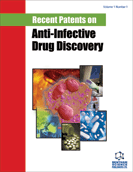Abstract
Background: Malaria is a deadly disease. It is mostly treated using 4- aminoquinoline derivatives such as chloroquine etc. because it is well-tolerated, displays low toxicity, and after administration, it is rapidly absorbed. The combination of 4-aminoquinoline with other classes of antimalarial drugs has been reported to be an effective approach for the treatment of malaria. Furthermore, some patents reported hybrids 4-aminoquinolines containing ferrocene moiety with potent antimalarial activity.
Objective: The objective of the current study is to prepare 4-aminoquinoline-ferrocene hybrids via esterification and amidation reactions. The compounds were characterized via FTIR, LC-MS and NMR spectroscopy. In vitro screening against chloroquine-sensitive P. falciparum parasite (NF54) at concentrations (1 μM and 5 μM) and an inhibitory concentration (full dose-response) was studied. Methods: The compounds were prepared via known reactions and monitored by Thin Layer Chromatography. The compounds were purified by column chromatography and characterized using FTIR, NMR and MS. In vitro antiplasmodial evaluation was performed against asexual parasite and chloroquine was used as a reference drug. Results: The percentage inhibition effects of the hybrid compounds were in a range of 97.9-102% at 5 μM and 36-96% at 1 μM. Furthermore, the IC50 values of the compounds were in the range of 0.7-1.6 μM when compared to the parent drug, 4-ferrocenylketobutanoic acid. Conclusion: The hybrid compounds displayed significant antimalarial activity when compared to the parent drug. However, they were not as effective as chloroquine on the drug-sensitive parasite. The findings revealed that 4-aminoquinolines and ferrocene are potential scaffolds for developing potent antimalarials.Keywords: Ferrocene, Plasmodium falciparum, 4-aminoquinoline, esterification reaction, hybrid compound, malaria.
Graphical Abstract
[http://dx.doi.org/10.1016/S0140-6736(18)30324-6] [PMID: 29631781]
[http://dx.doi.org/10.1016/j.biopha.2018.05.009] [PMID: 29758416]
[http://dx.doi.org/10.1016/j.ejmech.2018.02.021] [PMID: 29454189]
[http://dx.doi.org/10.1016/j.bmc.2014.12.018] [PMID: 25593097]
[http://dx.doi.org/10.1016/j.bmc.2014.05.024] [PMID: 24906512]
[http://dx.doi.org/10.1016/S2352-3026(15)00191-X] [PMID: 26686037]
[http://dx.doi.org/10.3390/molecules22122268]
[http://dx.doi.org/10.1038/s41598-017-16154-2] [PMID: 29162859]
[http://dx.doi.org/10.1186/1475-2875-6-81] [PMID: 17597537]
[http://dx.doi.org/10.1021/mp0500061] [PMID: 15934779]
[http://dx.doi.org/10.1007/s00044-013-0748-4]
[http://dx.doi.org/10.1016/j.jorganchem.2004.04.036]
[http://dx.doi.org/10.1021/jm100117e] [PMID: 20443628]
[http://dx.doi.org/10.1016/j.bmc.2012.10.019] [PMID: 23168082]
[http://dx.doi.org/10.1016/j.poly.2005.04.022]
[http://dx.doi.org/10.1007/s10904-015-0174-9]
[http://dx.doi.org/10.1021/jm200463z] [PMID: 21882831]
[http://dx.doi.org/10.1021/ml400164t] [PMID: 24900723]
[http://dx.doi.org/10.1002/anie.201907224] [PMID: 31290221]
[http://dx.doi.org/10.1016/j.ejmech.2012.01.043] [PMID: 22336384]
[http://dx.doi.org/10.1016/j.ejmech.2018.02.048] [PMID: 29499488]
[http://dx.doi.org/10.1016/B978-0-12-417205-0.00032-8]
[http://dx.doi.org/10.1021/ml4002985] [PMID: 24900781]
[http://dx.doi.org/10.1016/j.bmcl.2007.04.054] [PMID: 17482816]
[http://dx.doi.org/10.17159/0379-4350/2016/v69a7]
[http://dx.doi.org/10.1155/2014/987481]
[http://dx.doi.org/10.1016/j.ejmech.2016.09.044] [PMID: 27688182]
[http://dx.doi.org/10.1016/j.ejmech.2015.07.009] [PMID: 26188909]
[http://dx.doi.org/10.1016/j.ejmech.2017.07.061] [PMID: 28800458]
[http://dx.doi.org/10.1016/j.bmcl.2007.10.003] [PMID: 17949976]
[http://dx.doi.org/10.1021/jm301422h] [PMID: 23327489]
[http://dx.doi.org/10.1051/parasite/2011183207] [PMID: 21894260]
[http://dx.doi.org/10.1086/375419] [PMID: 12792863]
 10
10






















